Sitemap
A list of all the posts and pages found on the site. For you robots out there, there is an XML version available for digesting as well.
Pages
Posts
Future Blog Post
Published:
This post will show up by default. To disable scheduling of future posts, edit config.yml and set future: false.
Blog Post number 4
Published:
This is a sample blog post. Lorem ipsum I can’t remember the rest of lorem ipsum and don’t have an internet connection right now. Testing testing testing this blog post. Blog posts are cool.
Blog Post number 3
Published:
This is a sample blog post. Lorem ipsum I can’t remember the rest of lorem ipsum and don’t have an internet connection right now. Testing testing testing this blog post. Blog posts are cool.
Blog Post number 2
Published:
This is a sample blog post. Lorem ipsum I can’t remember the rest of lorem ipsum and don’t have an internet connection right now. Testing testing testing this blog post. Blog posts are cool.
Blog Post number 1
Published:
This is a sample blog post. Lorem ipsum I can’t remember the rest of lorem ipsum and don’t have an internet connection right now. Testing testing testing this blog post. Blog posts are cool.
awards
models
Leveraging Large Language Models for the Design and Optimization of Fluid Antenna Systems
Published:
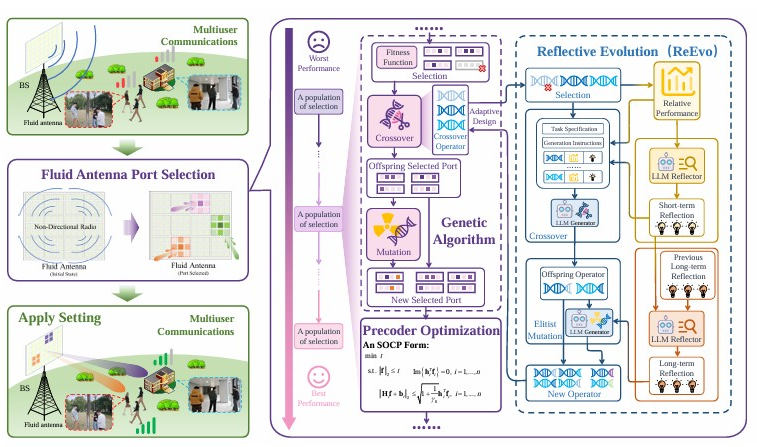 The paper investigates the potential of Large Language Models (LLMs) in optimizing Fluid Antenna Systems (FAS) for 6G networks. It addresses key challenges such as channel extrapolation, flexible precoder design, and cooperative FAS optimization through a novel LLM-driven framework and case studies, demonstrating significant performance gains.
The paper investigates the potential of Large Language Models (LLMs) in optimizing Fluid Antenna Systems (FAS) for 6G networks. It addresses key challenges such as channel extrapolation, flexible precoder design, and cooperative FAS optimization through a novel LLM-driven framework and case studies, demonstrating significant performance gains.
Recommended citation: Wang C, Wong K K, Li Z, et al. Large Language Model Empowered Design of Fluid Antenna Systems: Challenges, Frameworks, and Case Studies for 6G[J]. arXiv preprint arXiv:2506.14288, 2025.
Download Paper
portfolio
Portfolio item number 1
Short description of portfolio item number 1
Portfolio item number 2
Short description of portfolio item number 2 
publications
Two Novel Iterative Algorithms for Interference Alignment with Symbol Extensions in the MIMO Interference Channel
Published in Sci China Inf Sci, 2012
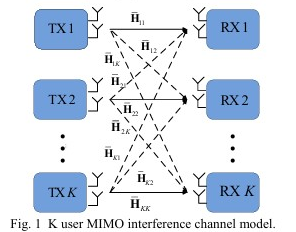 This paper proposes two novel iterative algorithms for interference alignment (IA) with symbol extensions in MIMO interference channels. The first algorithm minimizes the maximum per-user mean square error (MSE) while preserving the dimensionality of the desired signal. The second algorithm maximizes each receiver’s SINR while preserving the dimensionality of the desired signal.
This paper proposes two novel iterative algorithms for interference alignment (IA) with symbol extensions in MIMO interference channels. The first algorithm minimizes the maximum per-user mean square error (MSE) while preserving the dimensionality of the desired signal. The second algorithm maximizes each receiver’s SINR while preserving the dimensionality of the desired signal.
Recommended citation: Wang C, Deng K. Two novel iterative algorithms for interference alignment with symbol extensions in the MIMO interference channel[J]. Science China Information Sciences, 2014, 57: 1-14.
Download Paper
Linear Precoder Designs for Interference Alignment in Constant MIMO Interference Channels
Published in Proceedings of IEEE International Conference on wireless communication and networking (WCNC2013), 2013
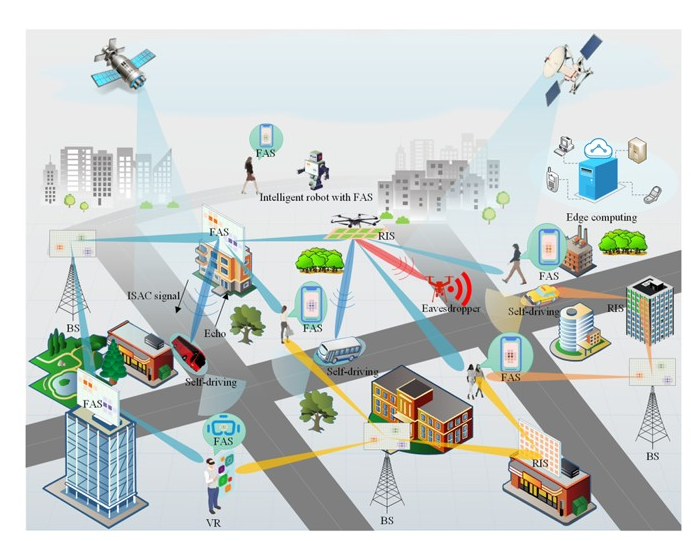 This paper proposes a novel one-sided algorithm for interference alignment (IA) in constant MIMO interference channels, using the steepest descent method to design linear precoders at transmitters only. The algorithm aims to minimize the spatial distance between different interference subspaces to achieve IA, avoiding the need for alternating between transmitters and receivers.
This paper proposes a novel one-sided algorithm for interference alignment (IA) in constant MIMO interference channels, using the steepest descent method to design linear precoders at transmitters only. The algorithm aims to minimize the spatial distance between different interference subspaces to achieve IA, avoiding the need for alternating between transmitters and receivers.
Recommended citation: Wang C, Zhang B, Zhang X, et al. Linear precoder designs for interference alignment in constant MIMO interference channels[C]//2013 IEEE Wireless Communications and Networking Conference (WCNC). IEEE, 2013: 3573-3578.
Download Paper
A Simple Amplify-and-Forward Opportunistic Relaying Based on Outdated Channel State Information
Published in Sci China Inf Sci, 2013
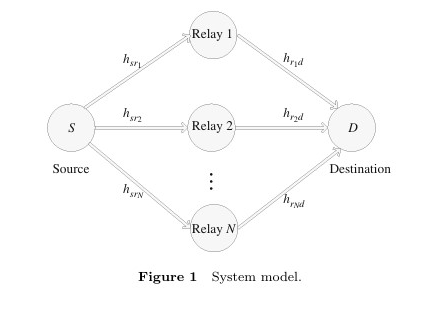 This research proposes a novel relay selection strategy for amplify-and-forward cooperative networks with outdated channel state information (CSI). By combining outdated and statistical CSI, the strategy optimizes symbol error probability (SEP) and outage probability at high SNR, achieving better performance than traditional methods in asymmetrical networks.
This research proposes a novel relay selection strategy for amplify-and-forward cooperative networks with outdated channel state information (CSI). By combining outdated and statistical CSI, the strategy optimizes symbol error probability (SEP) and outage probability at high SNR, achieving better performance than traditional methods in asymmetrical networks.
Recommended citation: Wang C, Deng K, Li Y B, et al. A simple amplify-and-forward opportunistic relaying based on outdated channel state information[J]. Science China Information Sciences, 2014, 57: 1-14.
Download Paper
Robust Joint Beamforming and Jamming for Secure AF Networks:Low-Complexity Design
Published in IEEE Transactions on Vehicular Technology, 2014
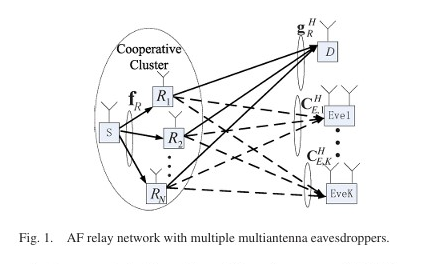 The paper proposes a robust joint CB and CJ design for an AF relay network with multiple eavesdroppers and imperfect CSI. Using SDR and ICA, the nonconvex problem is transformed into a sequence of convex problems to maximize the worst-case secrecy rate. The proposed design is efficient and guarantees convergence to a KKT solution.
The paper proposes a robust joint CB and CJ design for an AF relay network with multiple eavesdroppers and imperfect CSI. Using SDR and ICA, the nonconvex problem is transformed into a sequence of convex problems to maximize the worst-case secrecy rate. The proposed design is efficient and guarantees convergence to a KKT solution.
Recommended citation: Wang C, Wang H M. Robust joint beamforming and jamming for secure AF networks: Low-complexity design[J]. IEEE Transactions on Vehicular Technology, 2014, 64(5): 2192-2198.
Download Paper
Joint Relay Selection and Artificial Jamming Power Allocation for Secure DF Relay Networks
Published in IEEE ICC 2014, 2014
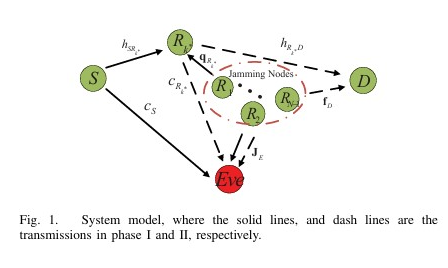 This paper proposes a joint relay selection and artificial jamming power allocation scheme for secure decode-and-forward (DF) relay networks. The authors aim to maximize the ergodic secrecy rate (ESR) by optimizing the power allocation between the confidential information and jamming signals, using only statistical channel state information (CSI) of the eavesdropper.
This paper proposes a joint relay selection and artificial jamming power allocation scheme for secure decode-and-forward (DF) relay networks. The authors aim to maximize the ergodic secrecy rate (ESR) by optimizing the power allocation between the confidential information and jamming signals, using only statistical channel state information (CSI) of the eavesdropper.
Recommended citation: Wang C, Wang H M. Joint relay selection and artificial jamming power allocation for secure DF relay networks[C]//2014 IEEE International Conference on Communications Workshops (ICC). IEEE, 2014: 819-824.
Download Paper
Hybrid Opportunistic Relaying and Jamming With Power Allocation for Secure Cooperative Networks
Published in IEEE Transactions on Wireless Communications, 2014
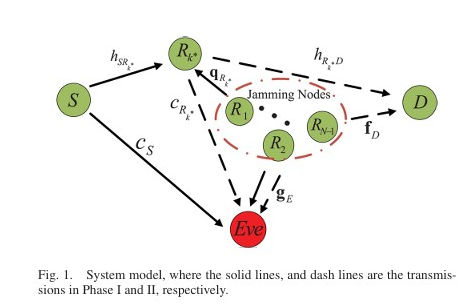 We proposes a hybrid opportunistic relaying and jamming scheme with power allocation to enhance security in cooperative networks. The study optimizes power allocation to maximize the ergodic secrecy rate (ESR) and analyzes the impact of outdated CSI and multiple eavesdroppers on the proposed scheme.
We proposes a hybrid opportunistic relaying and jamming scheme with power allocation to enhance security in cooperative networks. The study optimizes power allocation to maximize the ergodic secrecy rate (ESR) and analyzes the impact of outdated CSI and multiple eavesdroppers on the proposed scheme.
Recommended citation:
Download Paper
On the Secrecy Throughput Maximization for MISO Cognitive Radio Network in Slow Fading Channels
Published in IEEE Transactions on Wireless Communications, 2014
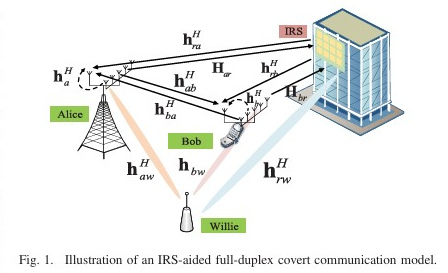 The paper proposes two strategies to maximize the secrecy throughput of the primary user in a cognitive radio network by optimizing beamforming, rate parameters, and power allocation between the information signal and artificial noise of the secondary user, subject to secrecy outage and throughput constraints.
The paper proposes two strategies to maximize the secrecy throughput of the primary user in a cognitive radio network by optimizing beamforming, rate parameters, and power allocation between the information signal and artificial noise of the secondary user, subject to secrecy outage and throughput constraints.
Recommended citation: Wang C, Wang H M. On the secrecy throughput maximization for MISO cognitive radio network in slow fading channels[J]. IEEE Transactions on Information Forensics and Security, 2014, 9(11): 1814-1827.
Download Paper
Uncoordinated Jammer Selection for Securing SIMOME Wiretap Channels:A Stochastic Geometry Approach
Published in IEEE Transactions on Wireless Communications, 2015
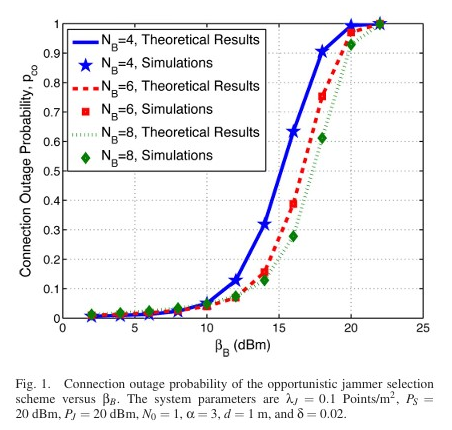 The paper proposes an opportunistic jammer selection scheme for the SIMOME wiretap channel. It selects single-antenna jammers to transmit Gaussian jamming signals to confuse eavesdroppers without centralized coordination. The scheme optimizes the selection threshold to maximize secrecy throughput and ergodic secrecy rate, achieving significant performance gains over random jammer selection.
The paper proposes an opportunistic jammer selection scheme for the SIMOME wiretap channel. It selects single-antenna jammers to transmit Gaussian jamming signals to confuse eavesdroppers without centralized coordination. The scheme optimizes the selection threshold to maximize secrecy throughput and ergodic secrecy rate, achieving significant performance gains over random jammer selection.
Recommended citation: Wang C, Wang H M, Xia X G, et al. Uncoordinated jammer selection for securing SIMOME wiretap channels: A stochastic geometry approach[J]. IEEE Transactions on Wireless Communications, 2015, 14(5): 2596-2612.
Download Paper
Robust joint beamforming and artificial noise design for secure AF relay networks
Published in IEEE ICCC 2014, 2015
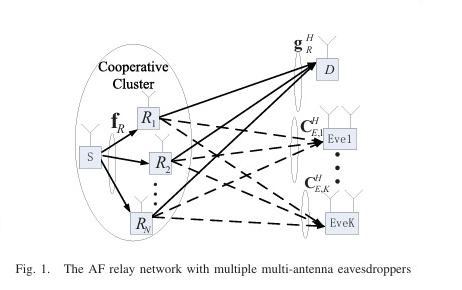 This paper proposes a robust joint design of distributed beamforming and artificial noise for secure amplify-and-forward (AF) relay networks in the presence of multiple multi-antenna eavesdroppers. The authors aim to maximize the worst-case secrecy rate under the total power constraint of all relay nodes, using semidefinite relaxation (SDR) and a one-dimensional search involving semidefinite programming (SDP).
This paper proposes a robust joint design of distributed beamforming and artificial noise for secure amplify-and-forward (AF) relay networks in the presence of multiple multi-antenna eavesdroppers. The authors aim to maximize the worst-case secrecy rate under the total power constraint of all relay nodes, using semidefinite relaxation (SDR) and a one-dimensional search involving semidefinite programming (SDP).
Recommended citation: Wang C, Wang H M. Robust joint beamforming and artificial noise design for secure AF relay networks[C]//2014 IEEE/CIC International Conference on Communications in China (ICCC). IEEE, 2014: 402-406.
Download Paper
Joint Beamforming and Power Allocation for Secrecy in Peer-to-Peer Relay Networks
Published in IEEE Transactions on Wireless Communications, 2015
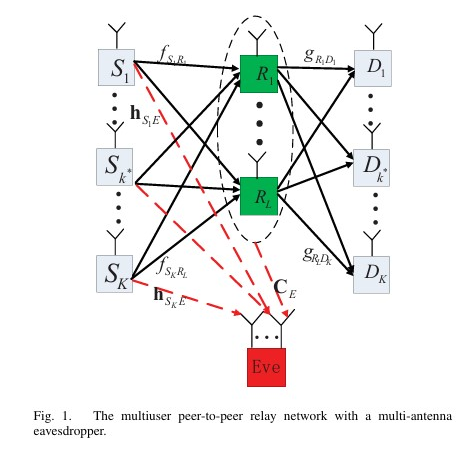 We proposes a joint beamforming and power allocation strategy for maximizing secrecy rate in multiuser peer-to-peer relay networks with a multi-antenna eavesdropper. By using null space beamforming to eliminate information leakage and sequential parametric convex approximation to solve the non-convex problem, the proposed method achieves significant performance improvements in secrecy rate, as demonstrated by simulations.
We proposes a joint beamforming and power allocation strategy for maximizing secrecy rate in multiuser peer-to-peer relay networks with a multi-antenna eavesdropper. By using null space beamforming to eliminate information leakage and sequential parametric convex approximation to solve the non-convex problem, the proposed method achieves significant performance improvements in secrecy rate, as demonstrated by simulations.
Recommended citation: Wang C, Wang H M, Ng D W K, et al. Joint beamforming and power allocation for secrecy in peer-to-peer relay networks[J]. IEEE Transactions on Wireless Communications, 2015, 14(6): 3280-3293.
Download Paper
Artificial Noise Assisted Secure Transmission under Training and Feedback
Published in IEEE Transactions on Signal Processing, 2015
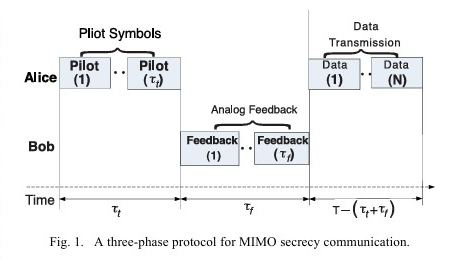 This paper proposes a framework for artificial noise-assisted secure transmission in MIMOME channels under training and feedback, optimizing power allocation and training overhead to maximize effective ergodic secrecy rate.
This paper proposes a framework for artificial noise-assisted secure transmission in MIMOME channels under training and feedback, optimizing power allocation and training overhead to maximize effective ergodic secrecy rate.
Recommended citation: Wang H M, Wang C, Ng D W K. Artificial noise assisted secure transmission under training and feedback[J]. IEEE transactions on signal processing, 2015, 63(23): 6285-6298.
Download Paper
Low-Overhead Distributed Jamming for SIMO Secrecy Transmission with Statistical CSI
Published in IEEE Signal Processing Letters, 2015
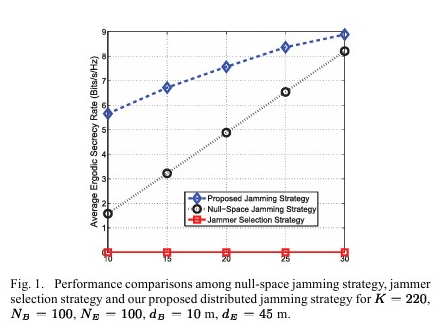 The paper proposes a low-overhead distributed jamming strategy to enhance SIMO secrecy transmission, optimizing jamming power based on statistical CSI for better physical layer security in massive MIMO systems.
The paper proposes a low-overhead distributed jamming strategy to enhance SIMO secrecy transmission, optimizing jamming power based on statistical CSI for better physical layer security in massive MIMO systems.
Recommended citation: Wang C, Wang H M, Wang B. Low-overhead distributed jamming for SIMO secrecy transmission with statistical CSI[J]. IEEE Signal Processing Letters, 2015, 22(12): 2294-2298.
Download Paper
Opportunistic Jamming for Enhancing Security:Stochastic Geometry Modeling and Analysis
Published in IEEE Transactions on Vehicular Technology, 2016
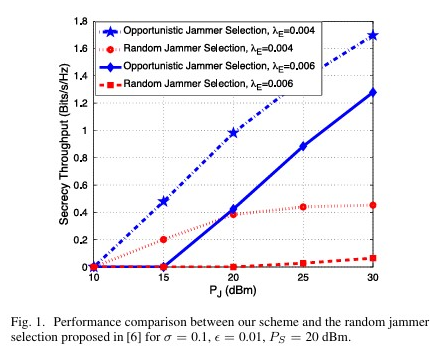 We proposes an opportunistic jammer selection scheme for enhancing security in a single-input–single-output multieavesdropper (SISOME) channel using stochastic geometry modeling and analysis. The scheme selects jammers based on their channel gains to the legitimate receiver, allowing them to transmit independent Gaussian jamming signals to confuse eavesdroppers. The authors derive the secrecy throughput and prove it is a quasi-concave function of the selection threshold, enabling efficient optimization. Simulation results demonstrate significant improvements in secrecy performance compared to random jammer selection schemes.
We proposes an opportunistic jammer selection scheme for enhancing security in a single-input–single-output multieavesdropper (SISOME) channel using stochastic geometry modeling and analysis. The scheme selects jammers based on their channel gains to the legitimate receiver, allowing them to transmit independent Gaussian jamming signals to confuse eavesdroppers. The authors derive the secrecy throughput and prove it is a quasi-concave function of the selection threshold, enabling efficient optimization. Simulation results demonstrate significant improvements in secrecy performance compared to random jammer selection schemes.
Recommended citation: Wang C, Wang H M. Opportunistic jamming for enhancing security: Stochastic geometry modeling and analysis[J]. IEEE Transactions on Vehicular Technology, 2016, 65(12): 10213-10217.
Download Paper
Artificial Noise Assisted Secure Transmission for Distributed Antenna System
Published in IEEE Transactions on Wireless Communications, 2016
 The paper proposes a distributed artificial noise scheme for enhancing security in distributed antenna systems (DAS) by optimizing power allocation to maximize the ergodic secrecy rate (ESR) using large-scale CSI.
The paper proposes a distributed artificial noise scheme for enhancing security in distributed antenna systems (DAS) by optimizing power allocation to maximize the ergodic secrecy rate (ESR) using large-scale CSI.
Recommended citation: Wang H M, Wang C, Ng D W K, et al. Artificial noise assisted secure transmission for distributed antenna systems[J]. IEEE Transactions on Signal Processing, 2016, 64(15): 4050-4064.
Download Paper
Physical layer security in millimeter wave cellular networks
Published in IEEE Transactions on Wireless Communications, 2016
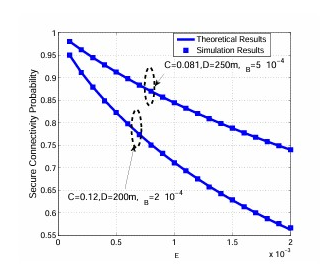 This paper investigates the physical layer security of millimeter wave (mmWave) cellular networks using stochastic geometry. It analyzes the secure connectivity probability and average number of perfect communication links per unit area for both noise-limited and interference-limited scenarios, considering non-colluding and colluding eavesdroppers. The study shows the importance of antenna array patterns and eavesdropper intensity in determining the secrecy performance and provides insights into optimal power allocation for artificial noise in mmWave networks.
This paper investigates the physical layer security of millimeter wave (mmWave) cellular networks using stochastic geometry. It analyzes the secure connectivity probability and average number of perfect communication links per unit area for both noise-limited and interference-limited scenarios, considering non-colluding and colluding eavesdroppers. The study shows the importance of antenna array patterns and eavesdropper intensity in determining the secrecy performance and provides insights into optimal power allocation for artificial noise in mmWave networks.
Recommended citation: Wang C, Wang H M. Physical layer security in millimeter wave cellular networks[J]. IEEE Transactions on Wireless Communications, 2016, 15(8): 5569-5585.
Download Paper
Impact of artificial noise on cellular networks:A stochastic geometry approach
Published in IEEE Transactions on Wireless Communications, 2016
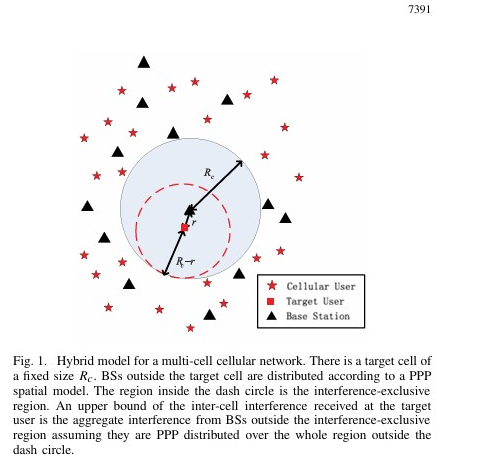 The paper investigates the impact of artificial noise (AN) on cellular network security using stochastic geometry. It analyzes connection and secrecy outages in a target cell, considering pilot contamination and inter-cell interference. Results show AN can enhance security but also increase interference, requiring optimized power allocation.
The paper investigates the impact of artificial noise (AN) on cellular network security using stochastic geometry. It analyzes connection and secrecy outages in a target cell, considering pilot contamination and inter-cell interference. Results show AN can enhance security but also increase interference, requiring optimized power allocation.
Recommended citation: Wang H M, Wang C, Zheng T X, et al. Impact of artificial noise on cellular networks: A stochastic geometry approach[J]. IEEE Transactions on Wireless Communications, 2016, 15(11): 7390-7404.
Download Paper
Physical Layer Security of Vehicular Networks:A Stochastic Geometry Approach
Published in 2020 IEEE International Conference on Communications Workshops (ICC Workshops), 2020
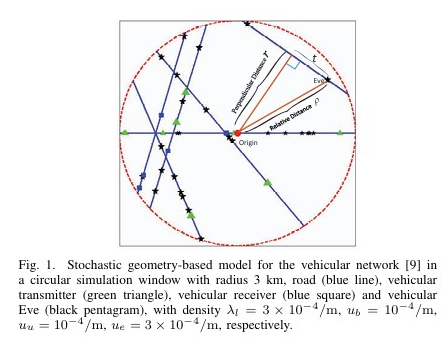 This paper proposes an analytical framework for studying the physical layer security (PLS) of vehicular networks using stochastic geometry. The spatial distribution of vehicles is modeled by Cox processes driven by a Poisson line process (PLP). The authors derive the coverage probability and secrecy probability to evaluate the effective secrecy throughput under a maximum signal-to-interference-ratio (SIR) association scheme.
This paper proposes an analytical framework for studying the physical layer security (PLS) of vehicular networks using stochastic geometry. The spatial distribution of vehicles is modeled by Cox processes driven by a Poisson line process (PLP). The authors derive the coverage probability and secrecy probability to evaluate the effective secrecy throughput under a maximum signal-to-interference-ratio (SIR) association scheme.
Recommended citation: Wang C, Li Z, Shi J, et al. Physical layer security of vehicular networks: A stochastic geometry approach[C]//2020 IEEE International Conference on Communications Workshops (ICC Workshops). IEEE, 2020: 1-7.
Download Paper
Physical Layer Security Enhancement Using Artificial Noise in Cellular Vehicle-to-Everything (C-V2X) Networks
Published in IEEE Transactions on Vehicular Technology, 2020
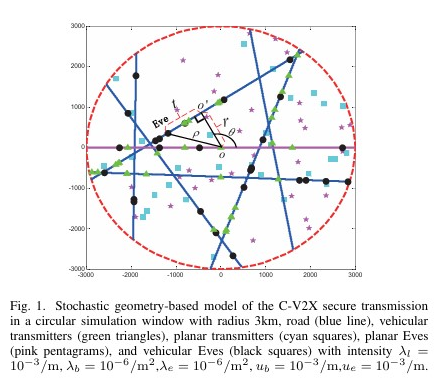 We investigates the physical layer security (PLS) of cellular vehicle-to-everything (C-V2X) networks using artificial noise (AN) and secure beamforming techniques. The authors build an analytical framework based on stochastic geometry to study the PLS of multi-antenna C-V2X networks. They derive closed-form expressions for coverage probability and secrecy probability and analyze the effective secrecy throughput to evaluate the network’s security performance. Simulation results show that increasing the number of transmit antennas improves the robustness of the secure transmission strategy and that the optimal power allocation ratio between confidential information and AN remains relatively stable for different numbers of antennas.
We investigates the physical layer security (PLS) of cellular vehicle-to-everything (C-V2X) networks using artificial noise (AN) and secure beamforming techniques. The authors build an analytical framework based on stochastic geometry to study the PLS of multi-antenna C-V2X networks. They derive closed-form expressions for coverage probability and secrecy probability and analyze the effective secrecy throughput to evaluate the network’s security performance. Simulation results show that increasing the number of transmit antennas improves the robustness of the secure transmission strategy and that the optimal power allocation ratio between confidential information and AN remains relatively stable for different numbers of antennas.
Recommended citation: Wang C, Li Z, Xia X G, et al. Physical layer security enhancement using artificial noise in cellular vehicle-to-everything (C-V2X) networks[J]. IEEE Transactions on Vehicular Technology, 2020, 69(12): 15253-15268.
Download Paper
Hybrid Analog-Digital Precoder Design for Securing Cognitive Millimeter Wave Networks
Published in IEEE Transactions on Information Forensics and Security, 2020
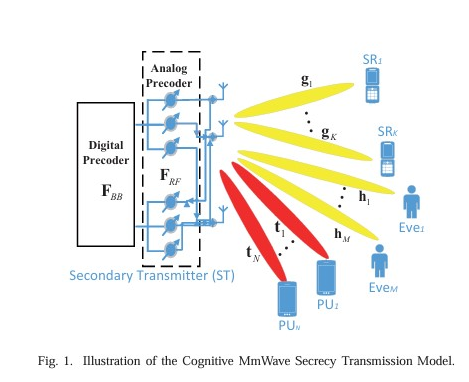 We investigates the hybrid secure precoder design for cognitive millimeter wave (mmWave) networks to enhance physical layer security. The authors aim to maximize the minimum secrecy rate of secondary users under constraints on interference power and quality of service. They formulate a non-convex optimization problem and propose a penalty dual decomposition (PDD) based iterative algorithm to solve it. Simulation results demonstrate the efficiency of the proposed algorithm in improving secrecy performance compared to traditional methods.
We investigates the hybrid secure precoder design for cognitive millimeter wave (mmWave) networks to enhance physical layer security. The authors aim to maximize the minimum secrecy rate of secondary users under constraints on interference power and quality of service. They formulate a non-convex optimization problem and propose a penalty dual decomposition (PDD) based iterative algorithm to solve it. Simulation results demonstrate the efficiency of the proposed algorithm in improving secrecy performance compared to traditional methods.
Recommended citation: Kong Z, Song J, Wang C, et al. Hybrid analog-digital precoder design for securing cognitive millimeter wave networks[J]. IEEE Transactions on Information Forensics and Security, 2020, 16: 4019-4034.
Download Paper
Joint Analog Beamforming and Jamming Optimization for Covert Millimeter Wave Communications
Published in GLOBECOM 2020 - 2020 IEEE Global Communications Conference, 2021
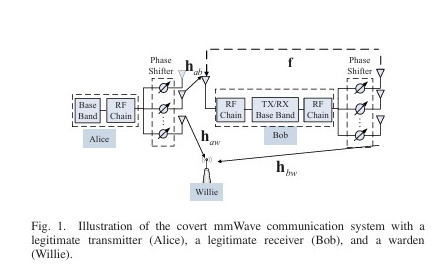 This paper investigates covert millimeter-wave (mmWave) communications, where a multi-antenna transmitter (Alice) sends information covertly to a full-duplex receiver (Bob) in the presence of a warden (Willie). The authors jointly optimize the analog beamforming at Alice and Bob to maximize the covert rate while satisfying covertness and communication outage constraints.
This paper investigates covert millimeter-wave (mmWave) communications, where a multi-antenna transmitter (Alice) sends information covertly to a full-duplex receiver (Bob) in the presence of a warden (Willie). The authors jointly optimize the analog beamforming at Alice and Bob to maximize the covert rate while satisfying covertness and communication outage constraints.
Recommended citation: Wang C, Li Z, Ng D W K. Joint analog beamforming and jamming optimization for covert millimeter wave communications[C]//GLOBECOM 2020-2020 IEEE Global Communications Conference. IEEE, 2020: 1-6.
Download Paper
Intelligent reflecting surface-assisted multi-antenna covert communications:Joint active and passive beamforming optimization
Published in IEEE Transactions on Communications, 2021
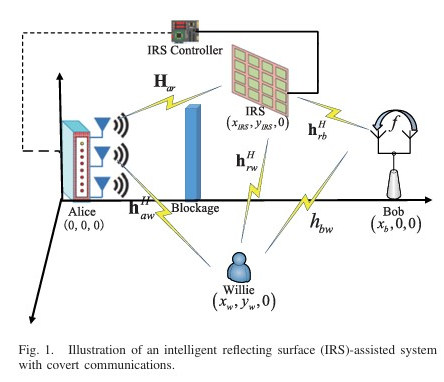 We investigates the joint active and passive beamforming optimization for intelligent reflecting surface (IRS)-assisted multi-antenna covert communications to maximize the covert rate while satisfying detection error probability and outage constraints.
We investigates the joint active and passive beamforming optimization for intelligent reflecting surface (IRS)-assisted multi-antenna covert communications to maximize the covert rate while satisfying detection error probability and outage constraints.
Recommended citation: Wang C, Li Z, Shi J, et al. Intelligent reflecting surface-assisted multi-antenna covert communications: Joint active and passive beamforming optimization[J]. IEEE Transactions on Communications, 2021, 69(6): 3984-4000.
Download Paper
Robust Hybrid Precoding Design for Securing Millimeter Wave IoT Networks Under Secrecy Outage Constraint
Published in IEEE Internet of Things Journal, 2021
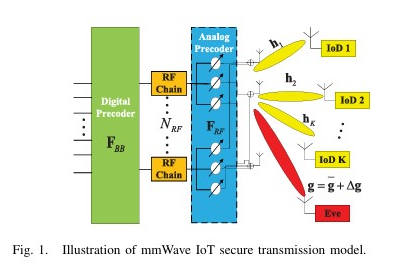 The paper proposes a robust hybrid precoding scheme for securing mmWave IoT networks under secrecy outage constraints. It maximizes the minimum secrecy rate among IoT devices by jointly optimizing analog and digital precoders using the PDD method, achieving significant performance gains.
The paper proposes a robust hybrid precoding scheme for securing mmWave IoT networks under secrecy outage constraints. It maximizes the minimum secrecy rate among IoT devices by jointly optimizing analog and digital precoders using the PDD method, achieving significant performance gains.
Recommended citation: Wang C, Li Z, Zheng T X, et al. Robust hybrid precoding design for securing millimeter-wave IoT networks under secrecy outage constraint[J]. IEEE Internet of Things Journal, 2021, 8(16): 13024-13038.
Download Paper
Hybrid Precoding for IRS-assisted Secure mmWave Communication System with SWIPT
Published in 2020 International Conference on Space-Air-Ground Computing (SAGC), 2021
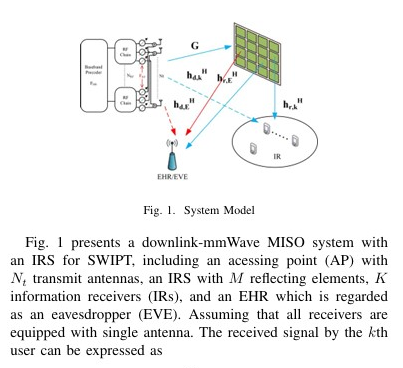 This paper investigates the hybrid precoding design for an intelligent reflecting surface (IRS)-assisted mmWave communication system with simultaneous wireless information and power transfer (SWIPT). The authors propose a joint optimization of the hybrid precoders and the phase shifts of the IRS to maximize the secrecy rate while satisfying energy harvesting and power constraints.
This paper investigates the hybrid precoding design for an intelligent reflecting surface (IRS)-assisted mmWave communication system with simultaneous wireless information and power transfer (SWIPT). The authors propose a joint optimization of the hybrid precoders and the phase shifts of the IRS to maximize the secrecy rate while satisfying energy harvesting and power constraints.
Recommended citation: Xue J, Zhou X, Wang C, et al. Hybrid precoding for IRS-assisted secure mmWave communication system with SWIPT[C]//2020 International Conference on Space-Air-Ground Computing (SAGC). IEEE, 2020: 82-86.
Download Paper
Wireless covert communications aided by distributed cooperative jamming over slow fading channels
Published in IEEE Transactions on Wireless Communications, 2021
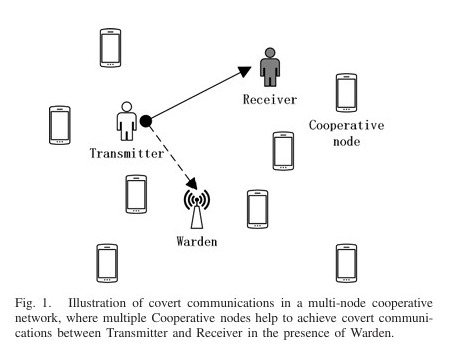 We investigates wireless covert communications aided by distributed cooperative jamming over slow fading channels. It proposes an uncoordinated jammer selection scheme where friendly nodes with low channel gains to the receiver are chosen as jammers to confuse the warden. The optimal selection threshold and transmission rate are jointly designed to maximize covert throughput under a covertness constraint. Results show that the multi-jammer scheme outperforms single-jammer methods and that the covert throughput improves significantly with more cooperative nodes, demonstrating the effectiveness of the proposed scheme.
We investigates wireless covert communications aided by distributed cooperative jamming over slow fading channels. It proposes an uncoordinated jammer selection scheme where friendly nodes with low channel gains to the receiver are chosen as jammers to confuse the warden. The optimal selection threshold and transmission rate are jointly designed to maximize covert throughput under a covertness constraint. Results show that the multi-jammer scheme outperforms single-jammer methods and that the covert throughput improves significantly with more cooperative nodes, demonstrating the effectiveness of the proposed scheme.
Recommended citation: Zheng T X, Yang Z, Wang C, et al. Wireless covert communications aided by distributed cooperative jamming over slow fading channels[J]. IEEE Transactions on Wireless Communications, 2021, 20(11): 7026-7039.
Download Paper
Intelligent reflecting surface-aided secure broadcasting in millimeter wave symbiotic radio networks
Published in IEEE Transactions on Vehicular Technology, 2021
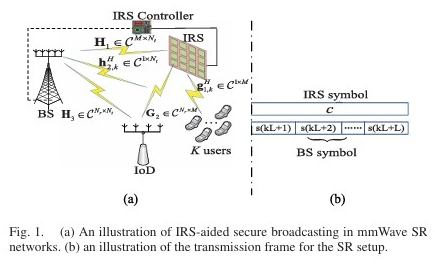 We investigates secure broadcast communications in IRS-aided mmWave symbiotic radio networks, where the IRS assists the BS in secure broadcasting while delivering its own information to an IoT device. The authors aim to maximize the minimum secrecy rate of multiple users by jointly designing the hybrid precoder at the BS and the passive beamformer at the IRS, subject to rate constraints. A computationally efficient iterative algorithm based on successive convex approximation is developed to solve the non-convex optimization problem. Simulation results validate the algorithm’s efficiency and superiority in improving the secrecy performance of the network.
We investigates secure broadcast communications in IRS-aided mmWave symbiotic radio networks, where the IRS assists the BS in secure broadcasting while delivering its own information to an IoT device. The authors aim to maximize the minimum secrecy rate of multiple users by jointly designing the hybrid precoder at the BS and the passive beamformer at the IRS, subject to rate constraints. A computationally efficient iterative algorithm based on successive convex approximation is developed to solve the non-convex optimization problem. Simulation results validate the algorithm’s efficiency and superiority in improving the secrecy performance of the network.
Recommended citation: Wang C, Li Z, Zheng T X, et al. Intelligent reflecting surface-aided secure broadcasting in millimeter wave symbiotic radio networks[J]. IEEE Transactions on Vehicular Technology, 2021, 70(10): 11050-11055.
Download Paper
Multiple UAV-Borne IRS-Aided Millimeter Wave Multicast Communications:A Joint Optimization Framework
Published in IEEE Transactions on Wireless Communications, 2021
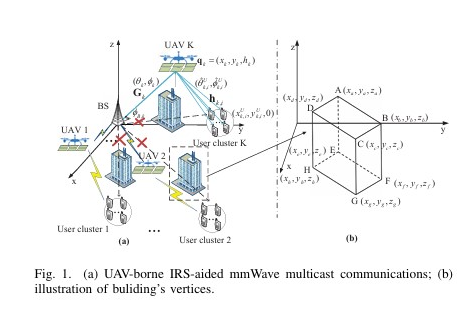 We design a resource allocation algorithm for UAV-borne IRS-aided mmWave multicast communications, jointly optimizing UAV placement, beamforming at the BS, and passive beamforming at the IRSs to maximize the minimum rate of user clusters.
We design a resource allocation algorithm for UAV-borne IRS-aided mmWave multicast communications, jointly optimizing UAV placement, beamforming at the BS, and passive beamforming at the IRSs to maximize the minimum rate of user clusters.
Recommended citation: Guo K, Wang C, Li Z, et al. Multiple UAV-borne IRS-aided millimeter wave multicast communications: A joint optimization framework[J]. IEEE Communications Letters, 2021, 25(11): 3674-3678.
Download Paper
Covert Rate Optimization of Millimeter Wave Full-Duplex Communications
Published in IEEE Transactions on Wireless Communications, 2021
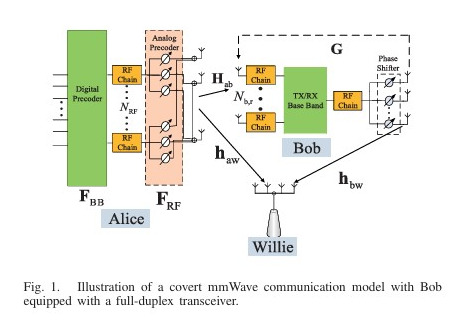 We investigates covert rate optimization for full-duplex millimeter wave communications. It proposes joint optimization frameworks for analog beamforming and jamming in both single and multiple data stream scenarios to maximize covert rate while satisfying detection error probability constraints, achieving significant performance gains.
We investigates covert rate optimization for full-duplex millimeter wave communications. It proposes joint optimization frameworks for analog beamforming and jamming in both single and multiple data stream scenarios to maximize covert rate while satisfying detection error probability constraints, achieving significant performance gains.
Recommended citation: Wang C, Li Z, Ng D W K. Covert rate optimization of millimeter wave full-duplex communications[J]. IEEE Transactions on Wireless Communications, 2021, 21(5): 2844-2861.
Download Paper
Optimal Joint Beamforming and Jamming Design for Secure and Covert URLLC
Published in 2021 IEEE Global Communications Conference (GLOBECOM), 2022
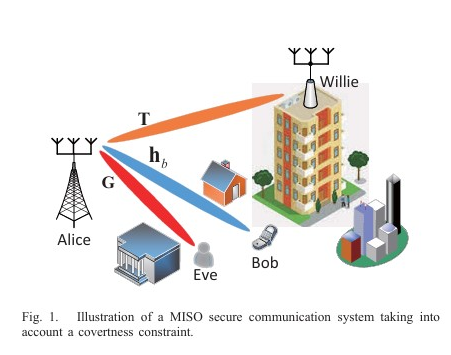 This paper proposes an optimal joint beamforming and jamming design for secure and covert ultra-reliable low-latency communication (URLLC) in a multiple-input single-output (MISO) downlink. The design aims to maximize the secrecy rate while satisfying covertness constraints, using a branch-reduce-and-bound (BRB) algorithm to solve the non-convex optimization problem.
This paper proposes an optimal joint beamforming and jamming design for secure and covert ultra-reliable low-latency communication (URLLC) in a multiple-input single-output (MISO) downlink. The design aims to maximize the secrecy rate while satisfying covertness constraints, using a branch-reduce-and-bound (BRB) algorithm to solve the non-convex optimization problem.
Recommended citation: Wang C, Li Z, Ng D W K. Optimal joint beamforming and jamming design for secure and covert URLLC[C]//2021 IEEE Global Communications Conference (GLOBECOM). IEEE, 2021: 1-7.
Download Paper
Achieving covertness and security in broadcast channels with finite blocklength
Published in IEEE Transactions on Wireless Communications, 2022
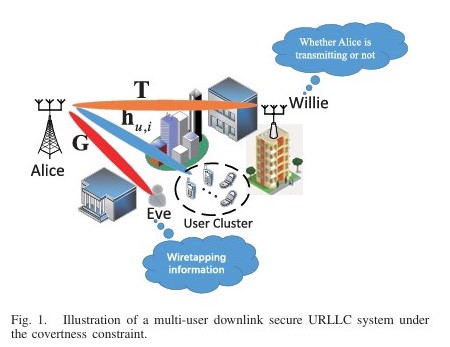 We proposes a symbol-level precoding-based scheme for STAR-RIS-aided dual-functional radar-communications (DFRC) systems. The aim is to securely transmit confidential information and perform target sensing concurrently. A joint optimization problem is formulated to maximize the average received radar sensing power, subject to constraints on communication users’ quality-of-service and security, as well as practical waveform design restrictions.
We proposes a symbol-level precoding-based scheme for STAR-RIS-aided dual-functional radar-communications (DFRC) systems. The aim is to securely transmit confidential information and perform target sensing concurrently. A joint optimization problem is formulated to maximize the average received radar sensing power, subject to constraints on communication users’ quality-of-service and security, as well as practical waveform design restrictions.
Recommended citation: Wang C, Li Z, Zhang H, et al. Achieving covertness and security in broadcast channels with finite blocklength[J]. IEEE Transactions on Wireless Communications, 2022, 21(9): 7624-7640.
Download Paper
Age of Information Minimization in Intelligent Reflecting Surface-Aided Covert Communications
Published in 2022 IEEE Globecom Workshops (GC Wkshps), 2023
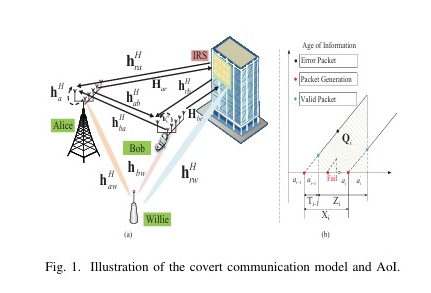 This paper investigates the minimization of covert information age in intelligent reflecting surface (IRS)-aided covert communications, jointly optimizing active/passive beamforming and blocklength under covertness and AoI constraints.
This paper investigates the minimization of covert information age in intelligent reflecting surface (IRS)-aided covert communications, jointly optimizing active/passive beamforming and blocklength under covertness and AoI constraints.
Recommended citation: Wang C, Li Z, Zhao Y, et al. Age of Information Minimization in Intelligent Reflecting Surface-Aided Covert Communications[C]//2022 IEEE Globecom Workshops (GC Wkshps). IEEE, 2022: 601-607.
Download Paper
ADMM-Induced Low-Complexity Precoder Design Algorithm for Rate-Splitting Multiple Access
Published in 2022 IEEE 22nd International Conference on Communication Technology (ICCT), 2023
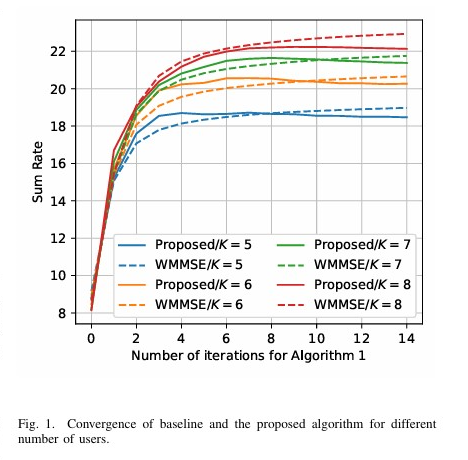 We proposes an ADMM-induced iterative algorithm to optimize the precoder for rate-splitting multiple access (RSMA) in multi-antenna downlink systems. The algorithm transforms the non-convex problem into convex subproblems using WMMSE and solves them in closed form with ADMM, achieving faster convergence and lower complexity than existing methods.
We proposes an ADMM-induced iterative algorithm to optimize the precoder for rate-splitting multiple access (RSMA) in multi-antenna downlink systems. The algorithm transforms the non-convex problem into convex subproblems using WMMSE and solves them in closed form with ADMM, achieving faster convergence and lower complexity than existing methods.
Recommended citation: Li G, Wang C, Zhang H. ADMM-Induced Low-Complexity Precoder Design Algorithm for Rate-Splitting Multiple Access[C]//2022 IEEE 22nd International Conference on Communication Technology (ICCT). IEEE, 2022: 49-54.
Download Paper
A Cooperative Deception Strategy for Covert Communication in Presence of a Multi-antenna Adversary
Published in IEEE Transactions on Communications, 2023
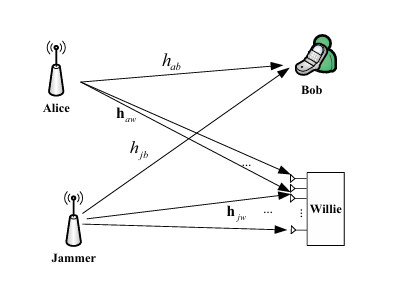 We investigates covert communication using a cooperative deception strategy against a multi-antenna adversary. It optimizes power allocation between a transmitter and a jammer under different CSI scenarios to maximize covert rate, showing improved performance and robustness compared to non-deception strategies.
We investigates covert communication using a cooperative deception strategy against a multi-antenna adversary. It optimizes power allocation between a transmitter and a jammer under different CSI scenarios to maximize covert rate, showing improved performance and robustness compared to non-deception strategies.
Recommended citation: Si, J., Liu, Z., Li, Z., Hu, H., Guan, L., Wang, C., & Al-Dhahir, N.. A cooperative deception strategy for covert communication in presence of a multi-antenna adversary[J]. IEEE Transactions on Communications, 2023, 71(8): 4778-4792.
Download Paper
QoS-Aware Precoder Optimization for Radar Sensing and Multiuser Communications Under Per-Antenna Power Constraints
Published in IEEE Transactions on Wireless Communications, 2023
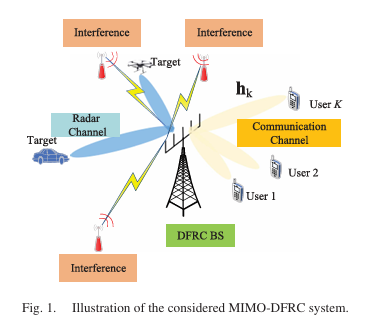 We proposes a symbol-level precoding-based scheme for STAR-RIS-aided dual-functional radar-communications (DFRC) systems. The aim is to securely transmit confidential information and perform target sensing concurrently. A joint optimization problem is formulated to maximize the average received radar sensing power, subject to constraints on communication users’ quality-of-service and security, as well as practical waveform design restrictions.
We proposes a symbol-level precoding-based scheme for STAR-RIS-aided dual-functional radar-communications (DFRC) systems. The aim is to securely transmit confidential information and perform target sensing concurrently. A joint optimization problem is formulated to maximize the average received radar sensing power, subject to constraints on communication users’ quality-of-service and security, as well as practical waveform design restrictions.
Recommended citation: Wang C, Li Z, Al-Dhahir N, et al. QoS-aware precoder optimization for radar sensing and multiuser communications under per-antenna power constraints[J]. IEEE Transactions on Signal Processing, 2023, 71: 2235-2250.
Download Paper
STAR-RIS-Enabled Secure Dual-Functional Radar-Communications:Joint Waveform and Reflective Beamforming Optimization
Published in IEEE Transactions on Information Forensics and Security, 2023
 We proposes a symbol-level precoding-based scheme for STAR-RIS-aided dual-functional radar-communications (DFRC) systems. The aim is to securely transmit confidential information and perform target sensing concurrently. A joint optimization problem is formulated to maximize the average received radar sensing power, subject to constraints on communication users’ quality-of-service and security, as well as practical waveform design restrictions.
We proposes a symbol-level precoding-based scheme for STAR-RIS-aided dual-functional radar-communications (DFRC) systems. The aim is to securely transmit confidential information and perform target sensing concurrently. A joint optimization problem is formulated to maximize the average received radar sensing power, subject to constraints on communication users’ quality-of-service and security, as well as practical waveform design restrictions.
Recommended citation: Wang C, Wang C C, Li Z, et al. STAR-RIS-enabled secure dual-functional radar-communications: Joint waveform and reflective beamforming optimization[J]. IEEE Transactions on Information Forensics and Security, 2023, 18: 4577-4592.
Download Paper
CVCA:A Complex-valued Classifiable Autoencoder for MmWave Massive MIMO Physical Layer Authentication
Published in 2023 IEEE Conf. on Computer Communications Workshops (INFOCOM Workshops), 2023
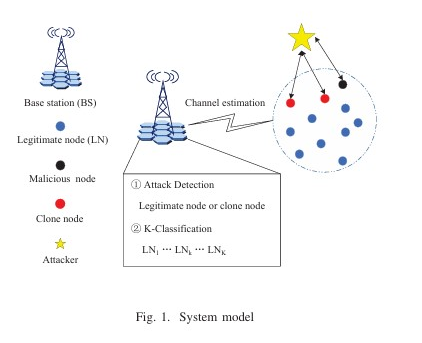 We proposes a deep learning-based PLA method for mmWave communications, using the spatiotemporal characteristics of mmWave channels as fingerprints to detect clone attacks and classify legitimate nodes via a novel complex-valued classifiable autoencoder and LSTM module, outperforming existing approaches.
We proposes a deep learning-based PLA method for mmWave communications, using the spatiotemporal characteristics of mmWave channels as fingerprints to detect clone attacks and classify legitimate nodes via a novel complex-valued classifiable autoencoder and LSTM module, outperforming existing approaches.
Recommended citation: Zeng X, Wang C, Wang C C, et al. CVCA: A Complex-Valued Classifiable Autoencoder for MmWave Massive MIMO Physical Layer Authentication[C]//IEEE INFOCOM 2023-IEEE Conference on Computer Communications Workshops (INFOCOM WKSHPS). IEEE, 2023: 1-6.
Download Paper
PHY Security Enhancement Exploiting STAR-RIS for Dual-functional Radar-Communication
Published in 2023 IEEE International Conference on Communications (ICC), 2023
 We proposes two novel iterative algorithms for interference alignment (IA) with symbol extensions in MIMO interference channels. The first algorithm minimizes the maximum per-user mean square error (MSE) while preserving the dimensionality of the desired signal. The second algorithm maximizes each receiver’s SINR while preserving the dimensionality of the desired signal.
We proposes two novel iterative algorithms for interference alignment (IA) with symbol extensions in MIMO interference channels. The first algorithm minimizes the maximum per-user mean square error (MSE) while preserving the dimensionality of the desired signal. The second algorithm maximizes each receiver’s SINR while preserving the dimensionality of the desired signal.
Recommended citation: Wang C, Wang C C, Li Z, et al. PHY security enhancement exploiting STAR-RIS for dual-functional radar-communication[C]//2023 IEEE International Conference on Communications Workshops (ICC Workshops). IEEE, 2023: 562-567.
Download Paper
Fluid Antenna System Liberating Multiuser MIMO for ISAC via Deep Reinforcement Learning
Published in IEEE Transactions on Wireless Communications, 2024
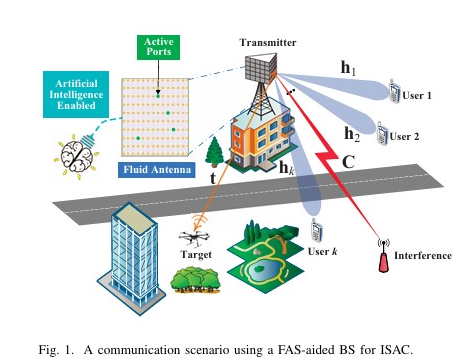 This paper investigates the joint optimization of port selection and precoding for a fluid antenna system (FAS)-assisted multiuser MIMO ISAC system using deep reinforcement learning to maximize the sum rate under a sensing constraint.
This paper investigates the joint optimization of port selection and precoding for a fluid antenna system (FAS)-assisted multiuser MIMO ISAC system using deep reinforcement learning to maximize the sum rate under a sensing constraint.
Recommended citation: Wang, Chao, et al. "Fluid antenna system liberating multiuser MIMO for ISAC via deep reinforcement learning." IEEE Transactions on Wireless Communications (2024).
Download Paper
Virtual FAS by Learning-Based Imaginary Antennas
Published in IEEE Wireless Communications Letters, 2024
 The article proposes a virtual Fluid Antenna System (FAS) using a transformer-based signal prediction network to infer received signals at imaginary antenna positions, enhancing MIMO receiver performance in multiuser channels.
The article proposes a virtual Fluid Antenna System (FAS) using a transformer-based signal prediction network to infer received signals at imaginary antenna positions, enhancing MIMO receiver performance in multiuser channels.
Recommended citation: Wong, Kai-Kit, et al. "Virtual FAS by learning-based imaginary antennas." IEEE Wireless Communications Letters (2024).
Download Paper
Learning-Induced Channel Extrapolation for Fluid Antenna Systems Using Asymmetric Graph Masked Autoencoder
Published in IEEE Wireless Communications Letters, 2024
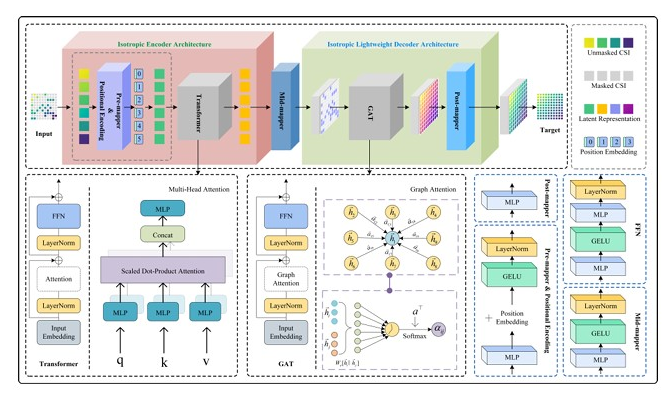 The paper proposes an asymmetric graph masked autoencoder (AGMAE) for channel state information (CSI) extrapolation in fluid antenna systems (FASs). The method leverages graph neural networks and attention mechanisms to reduce computational complexity and enhance generalization ability. Simulation results show that AGMAE achieves low prediction errors with only 5% observable antenna positions.
The paper proposes an asymmetric graph masked autoencoder (AGMAE) for channel state information (CSI) extrapolation in fluid antenna systems (FASs). The method leverages graph neural networks and attention mechanisms to reduce computational complexity and enhance generalization ability. Simulation results show that AGMAE achieves low prediction errors with only 5% observable antenna positions.
Recommended citation: Zhang, Haibin, et al. "Learning-induced channel extrapolation for fluid antenna systems using asymmetric graph masked autoencoder." IEEE Wireless Communications Letters (2024).
Download Paper
AI-empowered Fluid Antenna Systems:Opportunities, Challenges, and Future Direction
Published in IEEE Wireless Communications, 2024
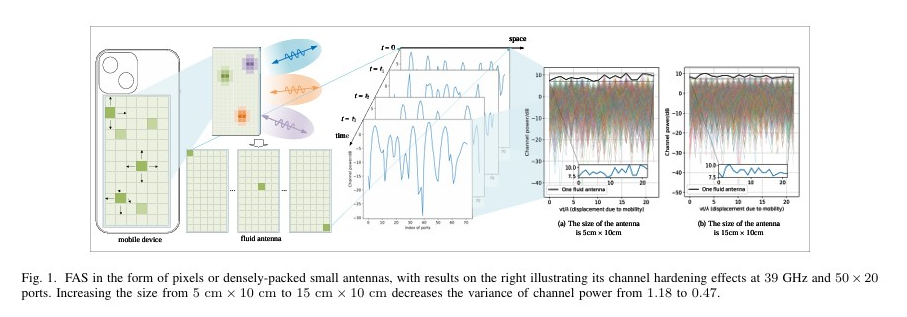 This article explores how AI empowers Fluid Antenna Systems (FAS) to enhance wireless communications by optimizing antenna positions and improving MIMO performance. It discusses opportunities, challenges, and future directions, using ISAC scenarios as a case study to illustrate potential gains.
This article explores how AI empowers Fluid Antenna Systems (FAS) to enhance wireless communications by optimizing antenna positions and improving MIMO performance. It discusses opportunities, challenges, and future directions, using ISAC scenarios as a case study to illustrate potential gains.
Recommended citation: Wang, Chao, et al. "AI-empowered fluid antenna systems: Opportunities, challenges, and future directions." IEEE Wireless Communications (2024).
Download Paper
submitted
Large Language Model Empowered Design of Fluid Antenna Systems:Challenges, Frameworks, and Case Studies for 6G
Published:
 The paper investigates the potential of Large Language Models (LLMs) in optimizing Fluid Antenna Systems (FAS) for 6G networks. It addresses key challenges such as channel extrapolation, flexible precoder design, and cooperative FAS optimization through a novel LLM-driven framework and case studies, demonstrating significant performance gains.
The paper investigates the potential of Large Language Models (LLMs) in optimizing Fluid Antenna Systems (FAS) for 6G networks. It addresses key challenges such as channel extrapolation, flexible precoder design, and cooperative FAS optimization through a novel LLM-driven framework and case studies, demonstrating significant performance gains.
Recommended citation: Wang C, Wong K K, Li Z, et al. Large Language Model Empowered Design of Fluid Antenna Systems: Challenges, Frameworks, and Case Studies for 6G[J]. arXiv preprint arXiv:2506.14288, 2025.
Download Paper
talks
Talk 1 on Relevant Topic in Your Field
Published:
This is a description of your talk, which is a markdown file that can be all markdown-ified like any other post. Yay markdown!
Conference Proceeding talk 3 on Relevant Topic in Your Field
Published:
This is a description of your conference proceedings talk, note the different field in type. You can put anything in this field.
teaching
Teaching experience 2
Workshop, University 1, Department, 2015
This is a description of a teaching experience. You can use markdown like any other post.
